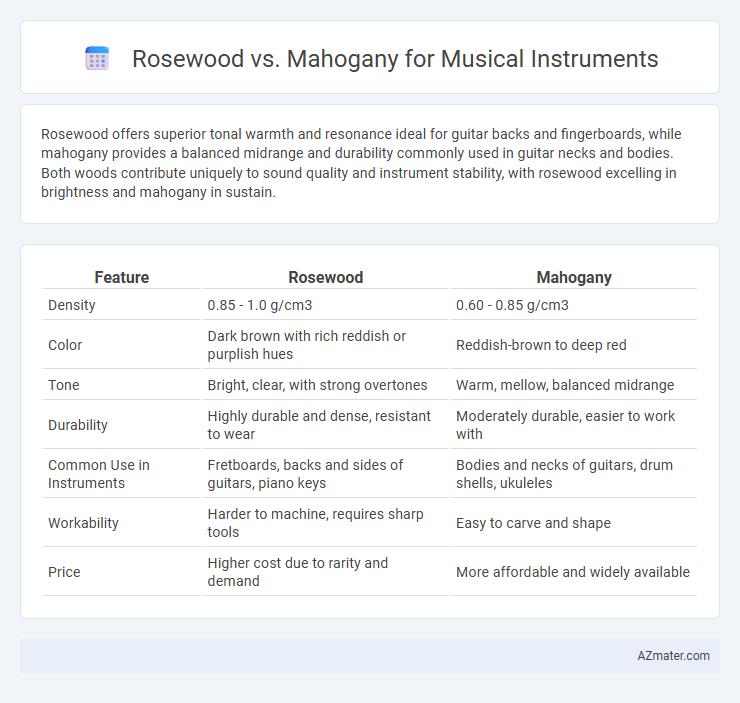Rosewood offers superior tonal warmth and resonance ideal for guitar backs and fingerboards, while mahogany provides a balanced midrange and durability commonly used in guitar necks and bodies. Both woods contribute uniquely to sound quality and instrument stability, with rosewood excelling in brightness and mahogany in sustain.
Table of Comparison
| Feature | Rosewood | Mahogany |
|---|---|---|
| Density | 0.85 - 1.0 g/cm3 | 0.60 - 0.85 g/cm3 |
| Color | Dark brown with rich reddish or purplish hues | Reddish-brown to deep red |
| Tone | Bright, clear, with strong overtones | Warm, mellow, balanced midrange |
| Durability | Highly durable and dense, resistant to wear | Moderately durable, easier to work with |
| Common Use in Instruments | Fretboards, backs and sides of guitars, piano keys | Bodies and necks of guitars, drum shells, ukuleles |
| Workability | Harder to machine, requires sharp tools | Easy to carve and shape |
| Price | Higher cost due to rarity and demand | More affordable and widely available |
Overview of Rosewood and Mahogany
Rosewood and mahogany are two popular tonewoods used in musical instruments, each offering distinct acoustic qualities; rosewood is prized for its rich overtones, warmth, and strong bass response, often used in guitar fretboards and backs, while mahogany provides a balanced midrange and clear, focused sound favored in guitar bodies and necks. Rosewood's dense grain structure contributes to its sustain and complex harmonic content, whereas mahogany's open grain and lighter density deliver a smoother, warmer tone with excellent projection. Both woods are valued for durability and aesthetic appeal, influencing the instrument's overall resonance and playability.
Historical Use in Musical Instruments
Rosewood and mahogany have been foundational materials in the construction of musical instruments, with rosewood prized for its dense, resonant qualities ideal for fingerboards and backs of guitars since the 19th century. Mahogany has historically been favored for its warm tonal properties and durability, commonly used in the bodies and necks of guitars, particularly in early 20th-century instruments by manufacturers like Gibson. The legacy of both woods reflects their impact on the tonal characteristics and craftsmanship of classical and acoustic guitars, contributing to the rich timbre and sustained resonance admired by musicians worldwide.
Physical Properties Comparison
Rosewood offers a higher density, typically around 0.85 g/cm3, compared to mahogany's lighter density near 0.60-0.85 g/cm3, contributing to a richer tonal resonance in musical instruments. Mahogany's fine, even grain provides excellent stability and workability, while rosewood features a tighter pore structure that enhances sustain and projection. The hardness of rosewood, measured at approximately 2200 on the Janka scale, surpasses mahogany's 800-900, making rosewood more durable for fingerboards and bridges but slightly more challenging to carve.
Tonal Characteristics of Rosewood
Rosewood is prized for its rich, warm tonal characteristics that produce deep bass response and bright, articulate highs, making it ideal for musical instruments such as guitars and pianos. Its dense grain structure enhances resonance and sustain, delivering a balanced sound with complex overtones. Rosewood's tonal depth and clarity provide musicians with versatile sound quality, especially favored in acoustic and classical instruments.
Tonal Characteristics of Mahogany
Mahogany is prized for its warm, rich tonal qualities, producing a strong midrange with a smooth, balanced sound that enhances the natural resonance of musical instruments. Its dense, tight grain structure contributes to excellent sustain and a focused projection, making it ideal for guitars and other stringed instruments where clarity and depth are crucial. Compared to rosewood, mahogany offers a slightly softer attack and a more rounded tone, favored by musicians seeking warmth and subtle complexity in their sound.
Suitability for Acoustic Guitars
Rosewood offers rich tonal warmth and pronounced overtones, making it ideal for acoustic guitar backs and sides, enhancing sound projection and sustain. Mahogany provides a balanced, focused tone with strong midrange presence, favored for a clear, punchy sound and durability in guitar construction. Acoustic guitars with rosewood tend to deliver complex, resonant audio, while mahogany models emphasize clarity and resonance, catering to different playing styles and tonal preferences.
Rosewood vs Mahogany in Electric Guitars
Rosewood and mahogany are key tonewoods used in electric guitars, offering distinct sonic qualities and aesthetic characteristics. Rosewood is prized for its rich overtones, bright articulation, and smooth sustain, making it ideal for fretboards and fingerboards that enhance playability and tonal clarity. Mahogany provides warmth, depth, and resonance with strong midrange frequencies, commonly used in guitar bodies to deliver a fuller, thicker sound favored in genres like blues and rock.
Durability and Maintenance Factors
Rosewood offers excellent durability with natural oils that resist moisture and reduce the need for frequent maintenance, making it ideal for long-lasting musical instruments. Mahogany is also durable but tends to require more regular care to prevent drying and cracking due to its less dense grain structure. Both woods provide robust sound quality, yet rosewood's higher resistance to wear and minimal upkeep demands make it a preferred choice for instruments subjected to rigorous use.
Environmental Impact and Availability
Rosewood, often sourced from slow-growing tropical trees, faces strict regulations under CITES due to overharvesting and habitat loss, leading to limited availability and increased environmental concerns. Mahogany, while also subject to deforestation, is generally more sustainably harvested and better managed through reforestation programs, making it relatively more accessible and environmentally friendly for musical instrument production. Choosing mahogany can reduce ecological footprints by supporting forests with established conservation efforts, whereas rosewood's scarcity and protection status often contribute to illegal logging and ecological degradation.
Choosing the Right Wood for Your Sound
Rosewood offers rich overtones and warm resonance, making it ideal for fingerstyle guitars and acoustic instruments requiring complex tonal depth. Mahogany provides a focused, punchy sound with emphasized midrange frequencies, favored for electric guitar backs and necks to deliver a strong, balanced tone. Selecting between rosewood and mahogany depends on whether you prefer intricate harmonic richness or clear, robust midrange presence in your musical instrument.

Infographic: Rosewood vs Mahogany for Musical Instrument
 azmater.com
azmater.com